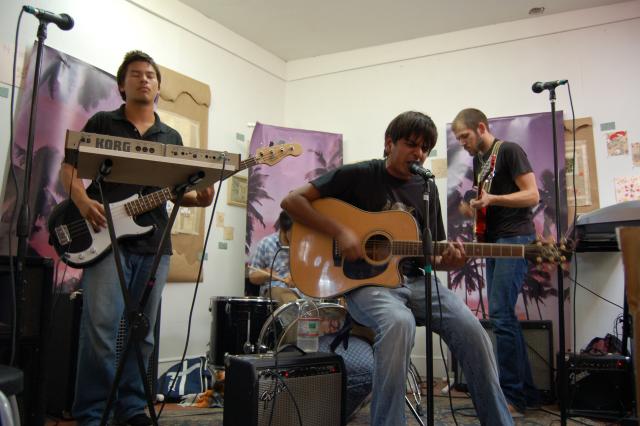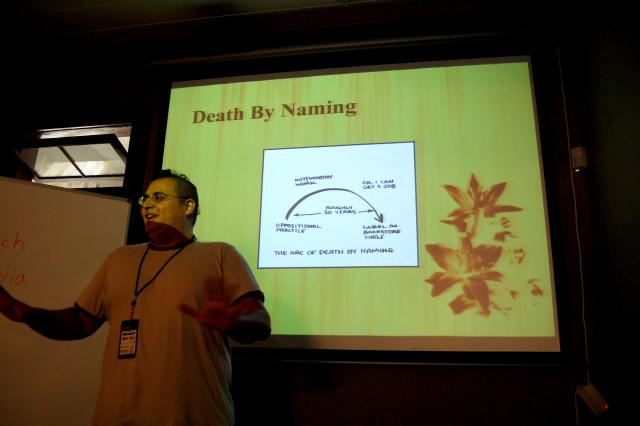The name of my Dissertation is “The Anthropologist’s guide to the 21st century: A look at online and offline car culture in Central Texas. When I came up with title it was a remark on how I had been trained in a traditional anthropological background. I had performed traditional ethnography throughout my graduate work in addition to taking many courses on general qualitative analysis. However I never felt fully apart of the canon. I would carry discussions with my colleagues about various ethnographic work and approaches.
Most of what would be discussed is how to file with the Internal Review Board for interview approval as well as how to interview and talk with subjects. However, my interest would always seem to stray more towards relating to the subjects and trying to understand them rather then purely retrieving data sets as many of my colleagues desired.
I believe a lot of my dis-connect also came from the fact that unlike many of my colleagues I was not interested in allowing my academic financial funding direct my research. Instead I believed in allowing my own financial funding direct my research.
What I mean by this is that as I would work on my ethnographic projects both in and out of classes I would slowly depart from working with professors who were academically funding the initiatives and find my own way for funding such efforts.
Now I should be clear that I still was under academic guidance, however my approaches and my direction were more facilitated then dictated since I was not bound by grants and specific research results.
One such project took place in 2005 when I decided to produce a Creative Commons based album and release it both within local music stores and also online. The project developed out of three separate previous initiatives. One was my own interest in record stores in Central Texas. I was so interested in record stores I had spent a whole year going to each store and talking with the owners and photographing each store. I compiled all of the information onto a website called ctxgrooves.com. (I have since done something similar with my dissertation, creating ctxracing.com)

The other initiative sprouted from a former student of mine Praveen Ayagari, a student who began making music in our class and was highly successful and began producing singles.


The third initiative was an open source peer-to-peer video streaming protocol I was working on with Brandon Wiley at the Foundation For Decentralization Research. One of my duties included finding out more about Creative Common’s licensing.

Now this is where I put my anthropological hat on and want to make something clear. With all three of these initiatives I just mentioned, it should be noted that while I was participating in them, as with all my research I am always looking at them from a capitalists perspective, in reference to Bourdieu.
However my idea of capital transfers beyond just social and cultural and into micro capital such as technical, academic and hobby specific.
So with this framework of capital I put together the idea to perform an experimental album release of Praveen’s singles, which we would Creative Common’s license and release in record stores and online through ACTLab.tv.
This project involved us making the physical CD’s, having the tracks mastered by a producers/audio engineer, myself propositioning each local record store, as well as myself working with Praveen throughout the process to assure his artistic intent was being realized.
And last but not least, throughout the whole process I was to document each step and then offer analysis of the out come. My main analysis and verbiage for my project came from my direct experiences. Meaning, while I had read theoretical frameworks for anthropological work, other then Bourdieu’s capital, I highly dis regarded such works due to the fact that I do not identify with them.
Instead I went with how I felt I could best describe my experiences and my work. I used my own words, both from the direct experiences and from my own previous experiences and built my own tools and theories.
While to many this might sound arrogant and disrespectful to the academic canon set before me, I would like to propose another perspective.
If you look at my social, cultural, economic and academic background (i.e. read transformative intellectuals), you will see that I have never been fully received by academia. The way I inherently think and process my ideas have never fully functioned within the framework of western European education.
Because of this, my ideas have always been pushed into the “other” category; much like my racial background or my over weightiness or my pedagogical practices. And having been told by traditional academia that I am the other, I have actively rejected their framework.
As Edward James Olmos’ character in the movie Selena said, “We are too white for the Mexicans and too dark for the Americans” (paraphrased). My cultural, social and academic background has trained me to depart from the mainstays of the fields I study and to look for new and interesting grounds. I have also learned that it is ok to describe such new landscapes in my native tongue, to be proud of my approaches, but to always use them with an open ear for positive criticism and outreach.

So with this framework in mind and my technological background I set forth to create a dissertation I felt fully showcased and demonstrated new and innovative works in my own tongue that can be “code-switched” by academics to spread new ways of thinking about anthropology and other ideas explored within my work.
Taking the above into consideration, in the summer of 2007 I began to become heavily involved with car culture in central Texas through my own interests, not academically. During this time I was also exploring my options for my dissertation, I knew I could easily throw something together about Facebook, MySpace, Twitter and New Media in general and have a good ol’ academic honky dory story. However I felt I would be selling myself and the academic canon short. I knew my work would fall into an esoteric technological academic abyss where 10 years from now it would have been forgotten.
However, as I developed relationships within the central Texas car scene I quickly came to realize how much potential there was for a story to be told, a timeless story. And there was room for experience, interpretation, risk and more. As I met the elders and n00b’s of the car scene I quickly became enthralled with the idea how hierarchies worked and how such systems existed both online and offline.
Taking my previous methodology into consideration I dived right in. Over the next 2 years I would fully emerge myself into the various car scenes in Central Texas. Whether it was street racing, drag racing, road racing, electric cars or automotive performance shops I was there, everyday all day. Every night I would come home and write, capture my videos, download my photos and update my dissertation blog with new information.

Which brings me to a good point-the “blog”. Many people asked me how I decided to use a blog rather then writing a traditional paper. Almost all of my academic colleagues and peers sited the fact that it would not be widely accepted and that I would be ridiculed for doing such work.
What they did not seem to realize is that I was already being ridiculed for they way I teach, the people I work with, the way I looked and the way I wrote. So for me to take it one step further in a direction that I felt academia needed to be going at the risk of being criticized by the elders of our canon was a no brainier for me. What did I have to lose compared to what I had to gain?
Having chosen a blog I have been able to not only write, but produce videos and photos for my dissertation, all while being able to get real time feedback from all forms of readers. Some have been academic, some have been in the automotive field and others who happen to stumble across my work while “on the internet”.
This cross pollenization of influence has created something that I believe moves beyond just being an academic text, but something that can be shared beyond the ivory tower. It is a community oriented piece of work, one which I aim to use to intrigue both lay and expert readers a like.
If you look at the main articles you will see I discuss my experiences textually, videographically, and photographically. This allows people to enter my “texts” with various levels of interest of my work and be able to come away with some type of experience as well as an ability to add their own analysis of my style of presentation.
It has been interesting to receive feedback from professors who state my work is just videos and photos, not realizing that it is those pieces of work that they are attracted to and that they are actually dis-regarding the text featured in such articles (which often include 20+ pages of text along with the photos and videos).
The older academics in-ability to understand that my work is academic at heart has been interesting. They often view my work as entertainment, not realizing, that while I am shooting video and photos, I am also listening to my subjects and analyzing their statements and looking for further information about their cultural and social practices. However when I show my peers (i.e. other graduate students and undergraduates and fresh professors) they are able to quickly consume the videos, photos and text in a critical way. While wrapping up my dissertation I was asked by my department to sit on a panel about hacking the ivory tower. While being a panelist it quickly became clear to me the dis-connect of truly new and innovative technology with traditional academia. Tenured professors made proclamation that I would never receive tenure with my work due to that fact that it was on a blog. Others stated my work efforts were a lost cause that would be barred by traditional academia.
This in-ability of my professors to consume my texts is one which I actively addressed throughout my dissertation process. Creating consumables for which they feel they have concurred and fully understand seem to help this situation. Leaving ominous interpretation and explanation seems very academic, however I feel it leaves room for interpretation. I feel the best texts are ones that lead to more questions rather then answers.
However I took that all very differently then I think they expected, I quickly saw a divide between myself, my new technology savvy peers and my elder tenured professors of the department. I quickly realized while my work must satisfy the elders for me to successfully complete my PhD program, that if I wanted to be truly successful in my own academic pursuits and ones that my peers aspired to have exist, I must also represent and push new ways of thinking about critical post modern analysis and presentation of my work.